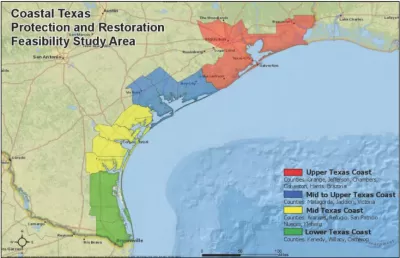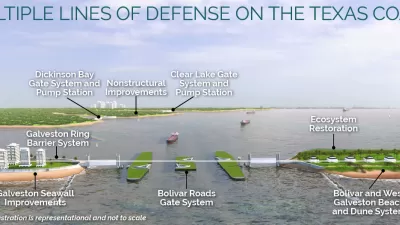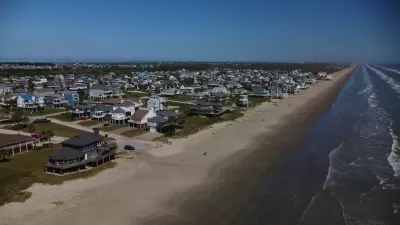The U.S. Army Corps of Engineers has proposed a suite of coastal infrastructure projects—i.e., floodgates and seawalls—to shore up the coast of Texas against Hurricane- and sea level rise-aided water.

"Following years of research, studies and public debate, the U.S. Army Corps of Engineers — in partnership with the state’s General Land Office — has recommended a multi-billion-dollar project that would protect the Houston area and its massive industrial complex from hurricane storm surge," reports Kiah Collier.
The Army Corps selected a final plan from four alternative proposals [pdf], with varying configurations of levees, seawalls, and locks, according to Collier, settling on a plan originally called the Ike Dike, but now called the "coastal spine."
The sweeping plan calls for the construction of a levee along Galveston Island and the peninsula to its north, Bolivar, as well as the installation of a gate between the two isles to keep storm surge from pouring between them into Galveston Bay and the Port of Houston. It also includes improvements to Galveston's existing seawall and a “ring levee” around the heart of the city. Such a structure would protect the backside of the most densely populated area from surge and flood waters retreating to the Gulf of Mexico following a storm.
The Army Corps "also identified extensive 'non-structural improvements' — such as beach renourishment and dune restoration — for much of the Texas coast," adds Collier.
FULL STORY: Army Corps, Texas officials propose sweeping hurricane protection plan

Trump Administration Could Effectively End Housing Voucher Program
Federal officials are eyeing major cuts to the Section 8 program that helps millions of low-income households pay rent.

Planetizen Federal Action Tracker
A weekly monitor of how Trump’s orders and actions are impacting planners and planning in America.

Canada vs. Kamala: Whose Liberal Housing Platform Comes Out on Top?
As Canada votes for a new Prime Minister, what can America learn from the leading liberal candidate of its neighbor to the north?

Washington State’s Parking Reform Law Could Unlock ‘Countless’ Acres for New Housing
A law that limits how much parking cities can require for residential amd commercial developments could lead to a construction boom.

Wildlife Rebounds After the Eaton Fire
Following the devastation of the Eaton Fire, the return of wildlife and the regrowth of native plants are offering powerful signs of resilience and renewal.

LA to Replace Inglewood Light Rail Project With Bus Shuttles
LA Metro says the change is in response to community engagement and that the new design will be ready before the 2028 Olympic Games.
Urban Design for Planners 1: Software Tools
This six-course series explores essential urban design concepts using open source software and equips planners with the tools they need to participate fully in the urban design process.
Planning for Universal Design
Learn the tools for implementing Universal Design in planning regulations.
Central Transportation Planning Staff/Boston Region MPO
Heyer Gruel & Associates PA
Institute for Housing and Urban Development Studies (IHS)
City of Grandview
Harvard GSD Executive Education
Regional Transportation Commission of Southern Nevada
Toledo-Lucas County Plan Commissions




























